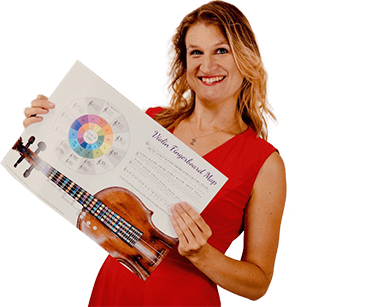Sound Great in High Positions on the Violin E String | Violin Lounge TV #417
Do you find it hard to get a beautiful resonant sound high up the E string?
Or do you struggle with squeaks and scratchy sounds as soon as you shift to a high position?
This video lesson will help!
Here are tips and tricks to sound beautifully high up the E string:
#1 Contact point
The higher you move up the string, the shorter the vibrating string length, which mean the point of contact should be near the bridge. Experiment which point of contact, so the place on the string where the bow hair touches the string, sounds best.
#2 Bow speed
When your bow speed is to low, so you’re bowing to slowly, you can get squeaks. When the bow speed is too high, you can get a glassy superficial sound. Experiment which bow speed gives you the best sound on your violin.
#3 Weight
On the E string you should use just a little bit or no weight on the bow. This can even mean that you should have the feeling of lifting the bow to get a good sound. The E string responds differently than the other strings on your violin.
Support my work by sharing this on Twitter:

Hi! I'm Zlata
Classical violinist helping you overcome technical struggles and play with feeling by improving your bow technique.
#4 Tilt the bow
By tilting the bow in the direction of the scroll, you’ll use less hair and get a softer sound. This can just get you the right sound high op the E string where the string is very tight. Experiment with tilting the bow.
#5 Rosin
With too much rosin on the bow, the E string can become very scratchy. With too little rosin, the violin won’t speak. Check if you’re using the right amount of rosin and experiment with less or more.
#6 Bow division
When playing the violin, you should be aware of where on the bow you play something all the time. The place on the bow, so lower half or upper half, can make a big difference. When you bow close to the frog, it can be quite a challenge to get a good sound in high positions on the E string.


This was a very timely video since I’m working on an arrangement of the Shostakovich waltz for variety orchestra which has both loud expressive sections and very fast sections that occur all around the E string. I’m used to playing with speed, weight and close to the bridge in higher positions but hadn’t realized the importance of lightening up on the e string and even tilting the bow. Since I’m going back and forth from E to A in some parts, this will take some slow practice to develop the reflex to lighten up at the right time! Thanks!
Awesome, Jane, enjoy the Shostakovich!
Thanks, Zlata
For your clear and systematic account of this. I appreciate the tip for the bow speed the most. Indeed, with very high notes one might be inclined to play too cautiously.
Kind regards, Erik
Glad it’s helpful, Erik!
Hi Zlata,
Another helpful video. The trouble is rarely caused by just one condition as that would be too easy to correct. We know the pressure point moves closer to the bridge as the string gets shorter. But we tend to think in terms of the lower 3 strings where we rarely play in positions as high as we do on the E-string. So I over-compensate by moving too close to the bridge and then find the happy medium for a good pressure point. With the right pressure point the bow speed almost takes care of itself, but results are still not good enough. The bow hair slant toward the scroll is a revelation since one naturally thinks more hair will make a fuller sound, but that seems to overpower the shortened string, almost like using too much pressure. This has a considerable effect on the sound, but one I have to think about many times before it will become automatic. Exactly the same happens controlling the bow weight, so controlling hair angle and bow weight need to work together. Finally, due to a recent increase in damp weather, I found I had to change to a less sticky rosin that wasn’t designed for dry climates. This improved all the strings in all positions, but it is even more critical playing high on the E-string. So 5 of these 6 conditions really made an instant and noticeable difference in my case. We understand them individually, but collectively they can be very helpful, or create a disaster. Number 6 on bow division is a continuing problem that needs constant work anyway.
Exactly, it’s a difficult puzzle. Thanks for adding the remark about rosin, because indeed the E string can be very sensitive for the type and amount of rosin.